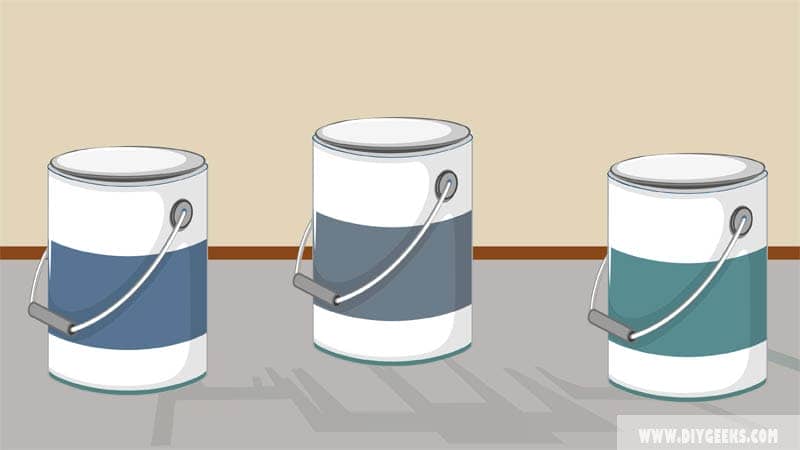Paint is a solid or semi-solid substance that creates a durable and solid film over the surfaces. There are different paint types and each has a different formula, finish type, dry time, and unique features.
Different paint types are listed below.
1. Oil-Based Paint
Oil-based paint is a paint type that uses synthetic or natural oils as its solvent (or carrier) or binders. Their oil-based formula gives the paint a glossy and low moisture-resistant finish that reflects light.
Oil-based paint takes longer to dry as its solvent (oil) takes longer to evaporate from the coating. You can use oil-based paint for medium-traffic interior and exterior surfaces, such as windows, door trims, baseboards, exterior walls, or furniture.
The oil-based paint advantages are listed below.
- Durable finish that withstands low water amounts.
- You can apply it over interior and exterior surfaces.
- High-gloss and reflective finish.
- Good surface adhesion.
The oil-based paint disadvantages are listed below.
- Slow dry time.
2. Water-Based Paint
Water-based or latex paint is a paint type that uses water as its main solvent (or carrier). It creates a dull and textured finish that doesn’t reflect light and covers surface imperfections.
Water-based paints have a simple formula that contains binders, pigments, and solvents — this formula makes the paint dry fast as water evaporates fast from the surface.
Use water-based paint for interior surfaces that aren’t exposed to constant water, moisture, or usage. The paint isn’t durable or moisture-resistant and can’t withstand water exposure and isn’t suited for exterior surfaces.
The water-based paint advantages are listed below.
- Fast dry time.
- Colorful finish.
- Easy to apply.
- Covers surface imperfections.
The water-based paint advantages are listed below.
- Low durability finish.
- Can’t withstand constant water exposure.
- Not suited for exterior surfaces.
3. Primers/Undercoats
Primers or undercoats are preparatory coatings applied over surfaces to enhance paint penetration and adhesion. Its purpose is to cover surface imperfections, cracks, and holes, and create a textured layer for paint to adhere over it.
Primers have a simple formula that contains no extra additives that make their finish dry faster. They have a similar proportion to paint — but primers can’t be left as the topcoat as it doesn’t have protective additives and will get removed if exposed to water.
There are several primer types that have different features. For instance, stain-blocking primers block stains on the surface from bleeding through the paint finish.
Use primers over surfaces riddled with holes, dents, scratches, and imperfections. The primer will cover the surface imperfections and enhance paint adhesion.
Primers can act as a sealer to cover surface pores and prevent paint over-absorption.
The primer advantages are listed below.
- Enhances paint penetration and adhesion.
- Fast dry time.
- Covers surface imperfections.
- Helps to create a smooth and durable finish.
- Prevents paint bleed-through.
The primer disadvantages are listed below.
- You can’t use it as the final coating.
- It covers surface texture and patterns.
4. Wood Sealers
Wood sealers are protective coatings that create a moisture-resistant layer (or barrier) and protect surfaces from moisture, water, scratches, and weather elements.
Most wood sealers are transparent and don’t change the surface or existing finish color shade. There are tinted sealers available too.
Use wood sealers over interior or exterior painted or bare wood to protect them from moisture, water, and weather elements. The sealer acts as a barrier and prevents water penetration.
The wood sealer advantages include the following things.
- Water repellency.
- UV resistance.
- Mold resistance.
- Enhanced durability.
Most common wood sealers include polyurethane, lacquer, wax, varnish, and shellac.
The wood sealer disadvantages include the following things.
- Hard to apply as they have a thick viscosity.
- Long dry time.
- Hard to apply paint over it.
5. Specialty Paints
Specialty paints refer to a paint type that is formulated for specific applications problems, or surfaces. For instance, aluminum paint, masonry paint, anti-corrosive paint, and spray paint.
These paints are formulated with the same additives normal paint is, but they often contain a few extra additives.
Aluminum Paint
Aluminum paint is designed to adhere to aluminum surfaces and create a protective layer over it. Its formula contains pigments, binders, and aluminum flakes. The presence of aluminum flake (powder) makes it heat-resistant and anti-corrosive.
Masonry Paint
Masonry paint is a water-based paint designed to be applied over interior and exterior masonry, brick, or stone surfaces. These surfaces are riddled with imperfections, and you need a special paint to cover these imperfections.
Corrosion-resistant Paint
Corrosive-resistant paint is used over metal and steel surfaces that protect them from corrosion and rust. They are formulated with extra additives that create a moisture-resistant finish that prevents water penetration and prevents rust from creating.
Popular types of anti-corrosive paint are automotive and Rust-leum paint.
Spray Paint
Spray paints are paint types applied from a pressurized container. They can be water-based, oil-based, sealers, and specialty paints.


